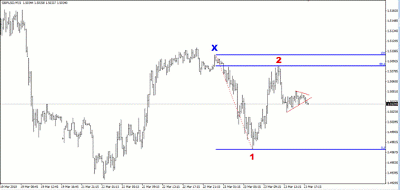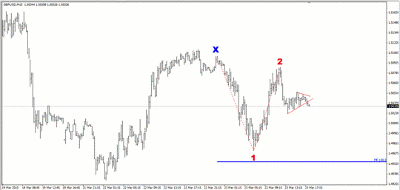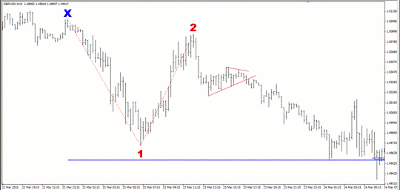Huzefa Hamid, a contributor to DailyForex.com and co-founder of The Forex Room, reviews a recent forex trade inspired by a triangle chart pattern and some reliable Fibonacci price levels.
In my last article on MoneyShow.com, I wrote about the importance of a largely overlooked chart pattern, the triangle, and how it can produce accurate trades with excellent risk/reward ratios.
Here, we’re going to look at this concept tied in with a Fibonacci retracement level that I love: the 88.6 Fib percentage. To recap, the Fibonacci “golden ratio” is 61.8%. If you square root that percentage, and then square root it again, you get 0.886, or 88.6%. I often use a bounce off the 88.6% Fib level as a trade entry.
See also: Fibonacci Analysis: Master the Basics
Let’s dive right in and look at an example. This is a live trade that I took on the GBP/USD on a 15-minute chart.
The following chart is the point at which I saw the trade developing:
My logic was this: The price moved from a high to a low (marked by the 100% and 0% lines) and then moved back up to the 88.6% level (highlighted by the small blue line). The price bounced off that level to the exact pip. I felt the price would continue moving down and extend the previous down move past the 0% level.
I could have entered a short position immediately, but the nearest place for a stop was around 45 pips away (above the previous high). While the profit target was over 80 pips, which gave a decent risk/reward, I felt I could get a tighter stop loss on a consolidation.
As a result, I waited for a pullback or consolidation (such as a triangle) from which to plan the trade. The risk with waiting is missing the trade entirely, as price could just rocket down and not consolidate at all.
Getting into the Trade
When I checked the chart again, I noticed a triangle consolidation where price had just broken out and decided this made a good entry point. I used a 25-pip stop, which was just above the triangle.
In the following chart, I’ve marked just the initial high as Point X, the low as Point 1, and the 88.6% level as Point 2 (and removed the other Fib levels for clarity). The triangle pattern is marked with the red lines.
Getting Out of the Trade
My target was a 100% extension of Wave 1. This means you take the size of Wave 1, i.e. from Point X to Point 1, and measure 100% of that size from Point 2. That gave me a target of about 80 pips away from my entry. This was a risk/reward ratio of over 1:3, which I think is very acceptable.
When it hit the target, it broke it by one or two pips before rebounding and going through it firmly. See the following chart:
Trading Conclusions
- A Fib level can often produce a good set-up, but if you don’t see it quick enough, you may miss the trade or have to accept a wide stop
- The triangle pattern can give you a tighter entry, and therefore, a better risk/reward ratio
- In forex, the pips made only make sense when you compare to the pips risked
By Huzefa Hamid, contributor, DailyForex.com, co-founder, The Forex Room
What is the minimum risk/reward ratio you look for on your trades? Please share your thoughts in the Comments section below.














